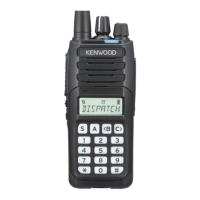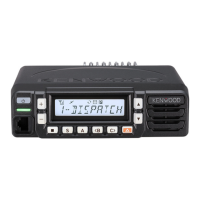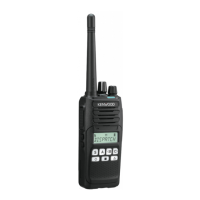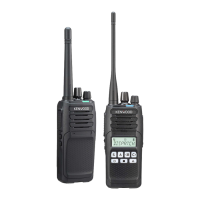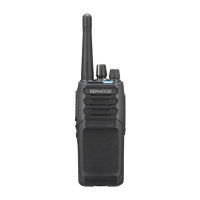
Do you have a question about the Kenwood NX-1300DE3 and is the answer not in the manual?
| Brand | Kenwood |
|---|---|
| Model | NX-1300DE3 |
| Category | Transceiver |
| Language | English |
Details on IP67 standards and maintenance for water resistance.
Crucial precautions to maintain the transceiver's water-resistant performance.
Instructions for attaching the antenna to the transceiver.
Steps for attaching the belt clip using screws.
Important warnings about battery handling and transceiver casing.
Procedure for installing the cap over speaker/microphone jacks.
Instructions for connecting speaker/microphone or headset.
Detailed explanation of transceiver buttons and their functions.
Procedure for turning the transceiver power on and off.
How to adjust the audio volume level using the control.
Steps to navigate and select operating zones and channels.
Guide on initiating group calls using NXDN or DMR protocols.
Guide on initiating individual calls using NXDN or DMR protocols.
Overview of how functions are accessed via buttons and menus.
Explanation of the Menu system for configuring functions on LCD models.
Step-by-step guide to navigate and access functions within the menu.
Indicates when no function is programmed on the transceiver.
Overview of the 2-tone signaling function for selective calling.
Function to quickly send DTMF codes from a pre-defined list.
How to turn the LCD display backlight on or off.
How to check the current battery power status of the transceiver.
How to initiate a Broadcast Group Call for one-way communication.
Function to prevent accidental button presses on the transceiver.
Sending assigned signaling from Call 1 to Call 6.
Sending a calling alert tone to another party.
Terminating voice communications by sending a request.
Sending an acknowledge call in response to a request.
Returning to the last called zone/channel during scan.
Using the selector to choose a channel.
Using the selector to change the channel number up or down.
Using buttons to increase or decrease the channel number.
Using buttons for continuous channel number adjustment.
Cancelling data transmission, rejecting calls, or disconnecting calls.
Sending a CW (Morse code) message.
Jumping directly to frequently used channels 1 through 5.
Setting the current channel as one of the Direct Channels 1-5.
Switching the display between zone-channel number and channel name.
Entering Emergency Mode for distress situations.
Adjusting the sensitivity of an external microphone.
Selecting the audio output for external or internal speakers.
Changing the volume level for tones.
Accessing a second programmed function assigned to a button.
Activating Group Call Mode for communication with a group.
Sending short messages to a specific group ID.
Sending status messages to a specific group ID.
Enabling or disabling high transmit power for increased range.
Jumping to a pre-programmed home channel.
Setting the current channel as the home channel.
Activating Individual Call Mode for communication with a single unit.
Sending short messages to a specific individual ID.
Sending status messages to a specific individual ID.
Automatic emergency mode activation if transceiver becomes disabled.
Manually moving to another channel during Site Roaming.
Enabling or disabling medium transmit power.
Accessing transceiver functions via the main menu.
Turning off signaling to listen to all received calls on a channel.
Temporarily turning off signaling to listen to calls.
Reprogramming QT/DQT codes using the OST List.
Entering OST List mode to select tone or code settings.
Hearing calls even if the received ID does not match.
Checking transceiver availability and communication range.
Function to "stun" a transceiver, making it temporarily unusable.
Automatically adjusting receiving volume for easy listening.
Saving operation and communication logs for field support.
Monitoring channels for signals and stopping on a channel with a signal.
Transmitting positioning data to a base station.
Sending short text messages like addresses or phone numbers.
Reducing the volume level of the speaker temporarily.
Adjusting the transceiver squelch level for signal reception.
Turning off the squelch to hear weak signals.
Temporarily turning off the squelch for better reception.
Disabling alert tones, backlight, and LEDs for covert operations.
Redirecting signals directly to other members, bypassing repeaters.
Setting or entering a password to protect the transceiver.
Setting transmission audio characteristics (Flat, High boost, Low boost).
Adjusting internal/external microphone sensitivity for easy listening.
Adjusting the VOX (Voice Operated Transmission) Gain level.
Enabling or disabling hands-free transmission using voice.
Including or omitting zones from the Multi-Zone scan sequence.
Using the selector to choose a zone number.
Using the selector to increase or decrease the zone number.
Using buttons to increase or decrease the zone number.
Behavior when keypad buttons are pressed without a specific mode.
Using the keypad to enter Channel Entry Mode and input channel numbers.
Using keypad buttons to activate OST and select OST List numbers.
Using the keypad to enter Autodial Mode for list selection or manual input.
Sending DTMF codes by pressing keypad buttons without the PTT switch.
Using keypad to enter Status Mode for input.
Using keypad to enter Short Message Mode for input.
Using keypad to enter Individual Call Mode or Selcall Mode.
Entering Individual Call Mode for status message entry.
Entering Individual Call Mode for short message entry.
Using keypad to enter Group Call Mode or Selcall Mode.
Entering Group Call Mode for status message entry.
Entering Group Call Mode for short message entry.
Procedure for entering and confirming the transceiver password.
Monitoring channels for signals and stopping on a channel with a signal.
Temporarily removing channels from the scan sequence.
Automatically changing to a priority channel when a call is received.
Instructions for making DTMF calls using manual dialing or auto PTT.
Entering and transmitting DTMF codes stored for later use.
Function to disable a transceiver remotely if stolen or lost.
Switching the transceiver to secure or encrypted transmission.
Changing the scrambler code used for transmission.
Using QT/DQT tones to ignore calls from other users on the same channel.
Reprogramming QT/DQT codes using the OST List.
Using RAN for selective calling in NXDN digital communications.
Using Color Code for smooth communication in DMR protocol.
Opening squelch only for calls with matching 2-tone signals.
Opening squelch only for calls with matching DTMF codes.
Using MDC-1200 data system for signaling.
Opening squelch for calls matching FleetSync ID.
Optional signaling system for digital communications.
Making voice calls to a station or group of stations.
Structure of ID codes for fleet, individual, and group calls.
Sending pre-defined status messages.
Receiving short data messages up to 48 characters.
Transmitting GPS data manually or automatically.
Explains VOX and Semi-VOX transmission modes.
How to connect a headset and operate VOX transmission.
Steps for operating Semi-VOX for hands-free transmission.
Prevents channel overuse by limiting transmission time.
Extends battery life by reducing power consumption.
Alerts when the battery power is low and needs recharging.
Displays the strength of received signals.







